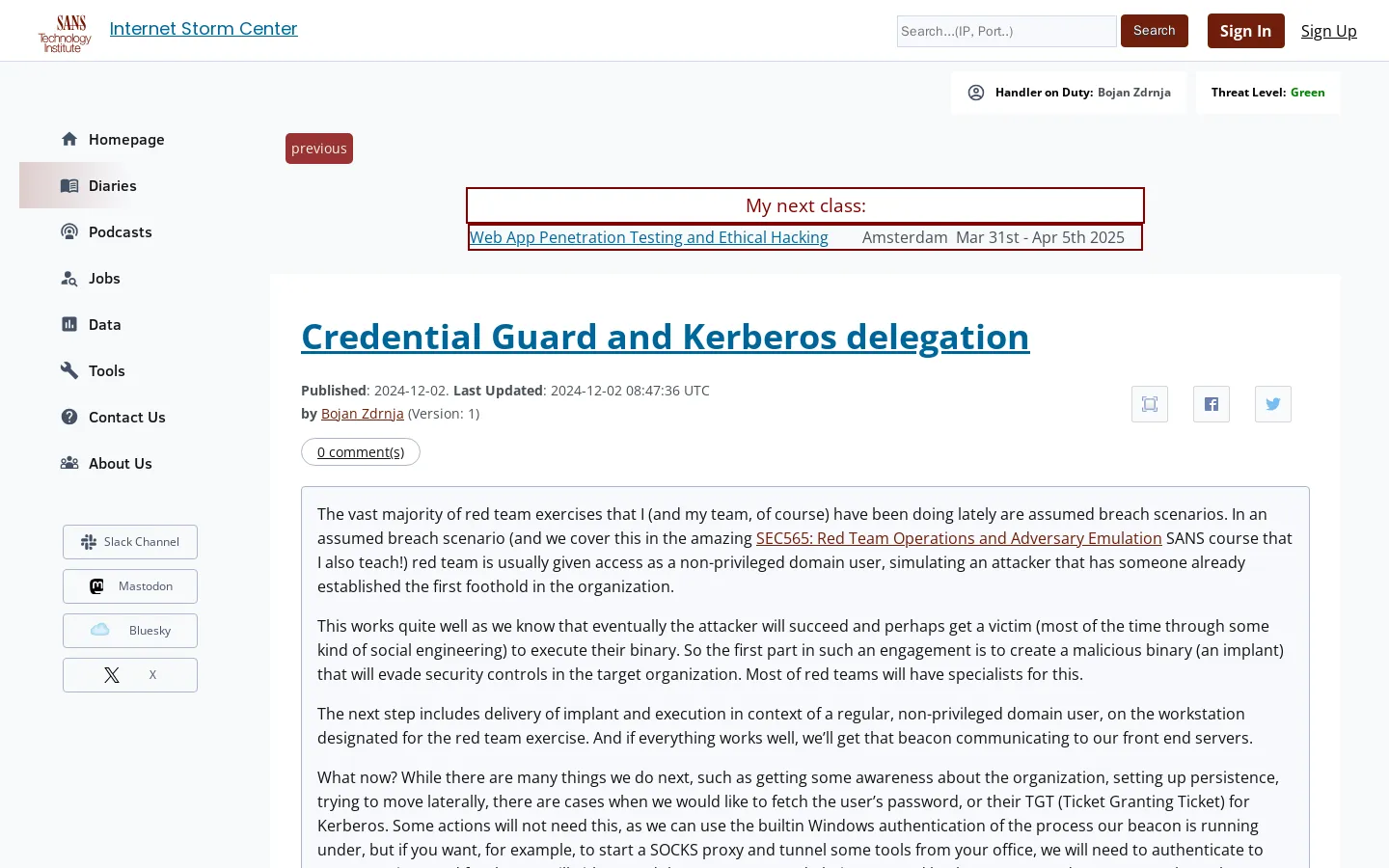
Credential Management Vulnerabilities and Best Practices Discussed
/ 5 min read
Quick take - A recent tutorial focused on user credential management highlighted the vulnerabilities associated with Kerberos Ticket Granting Tickets (TGTs) and provided best practices for organizations to enhance their security measures against cyber threats.
Fast Facts
-
Focus on Credential Vulnerabilities: The tutorial highlights the exploitation of Kerberos Ticket Granting Tickets (TGTs) as a significant security vulnerability, allowing attackers to gain unauthorized access without local admin privileges.
-
Best Practices for Security: Organizations are encouraged to implement robust security measures, such as enabling Credential Guard and fostering user education, to mitigate risks associated with credential theft and advanced persistent threats.
-
Understanding Attack Techniques: Participants learn about the methods cybercriminals use to extract user credentials, which helps organizations prepare and protect sensitive information more effectively.
-
Collaboration and Continuous Learning: Emphasizing teamwork between red and blue teams can enhance security assessments and foster a culture of continuous improvement in addressing vulnerabilities.
-
Recommended Tools for Red Teams: Tools like Cobalt Strike, Rubeus, and Mimikatz are essential for simulating attacks and assessing security postures, enabling red teams to identify and exploit credential vulnerabilities effectively.
Navigating the Complexities of Credential Management: Insights and Best Practices
In today’s digital age, where cyber threats loom large, understanding the intricacies of credential management is more crucial than ever. A recent tutorial has brought to light significant vulnerabilities in user credential management, particularly focusing on the exploitation of Kerberos Ticket Granting Tickets (TGTs). This session aims to educate organizations on both the techniques employed by cybercriminals and the best practices that can be adopted to enhance security measures.
Unveiling Vulnerabilities in Credential Management
The tutorial highlights a critical vulnerability: the ability to extract user credentials, specifically Kerberos TGTs, without requiring local administrator privileges. This vulnerability poses a substantial risk as attackers can exploit unconstrained delegation to gain unauthorized access to sensitive data. Such breaches allow cybercriminals to impersonate legitimate users, potentially leading to severe security incidents.
Understanding these vulnerabilities is essential for organizations aiming to protect their digital assets. The session underscores the importance of recognizing how attackers leverage these weaknesses to infiltrate systems and emphasizes the need for robust defenses.
Best Practices for Strengthening Security
To mitigate risks associated with credential theft and advanced persistent threats, the tutorial advocates for several best practices. One key recommendation is the activation of Credential Guard, a feature designed to protect user credentials from unauthorized access. This tool is part of a broader strategy that includes technical defenses and user education programs.
Organizations are encouraged to adopt a comprehensive security posture that not only involves deploying technological solutions but also fostering a culture of security awareness. By educating employees about potential threats and safe practices, companies can significantly reduce the risk of credential-related breaches.
Implications for Organizations
The insights from this tutorial are particularly relevant for organizations striving to fortify their defenses against sophisticated cyber threats. By understanding attacker methodologies, businesses can better prepare and safeguard their sensitive information. Implementing best practices such as enabling Credential Guard and promoting security awareness can enhance overall resilience against credential theft.
As cyber threats continue to evolve, staying informed about emerging vulnerabilities is crucial. Organizations must continuously adapt their security measures to address new challenges. This tutorial serves as a timely reminder of the need for vigilance in credential management and proactive steps that can be taken to prevent potential breaches.
Essential Steps for Effective Learning
For those looking to deepen their understanding of credential management vulnerabilities, the tutorial outlines four essential steps:
-
Understanding the Basics: Grasp foundational principles and familiarize yourself with key terminology.
-
Gathering Necessary Tools: Ensure you have the right software and resources at your disposal.
-
Following Step-by-Step Instructions: Adhere closely to detailed guides provided in the tutorial.
-
Practice and Application: Engage in hands-on exercises to reinforce learning and build confidence.
These steps provide a structured approach for learners to navigate the complexities of credential management effectively.
Enhancing Red Team Operations
In addition to individual learning, organizations can benefit from enhancing red team operations through specific strategies:
1. Understand the Environment Thoroughly
Conduct comprehensive reconnaissance to familiarize with architecture, key assets, and potential vulnerabilities.
2. Leverage Unconstrained Delegation Wisely
Identify services using this feature and assess how attackers could exploit it for unauthorized access.
3. Implement Credential Guard Awareness
Evaluate how well defenses like Credential Guard withstand various attack techniques.
4. Focus on Team Collaboration
Encourage open communication within red teams for innovative attack strategies and comprehensive assessments.
By implementing these best practices, red teams can significantly improve operational efficiency and effectiveness, providing valuable insights into organizational defenses.
Recommended Tools for Red Team Operations
For effective red team operations in assumed breach scenarios, several tools are recommended:
-
Cobalt Strike: Simulates real-world attacks for vulnerability identification.
-
Rubeus: Facilitates Kerberos ticket manipulation for exploiting authentication vulnerabilities.
-
Mimikatz: Extracts credentials from memory, offering insights into potential breach methods.
-
tgtdelegation BOF (Beacon Object File): Enables delegation attacks for privilege escalation and lateral movement.
Integrating these tools into operations allows red teams to simulate sophisticated attacks, providing organizations with critical insights needed to bolster defenses against potential threats.
By staying informed about these vulnerabilities and adopting proactive measures, organizations can enhance their security posture and better protect themselves against evolving cyber threats.
Original Source: Read the Full Article Here



